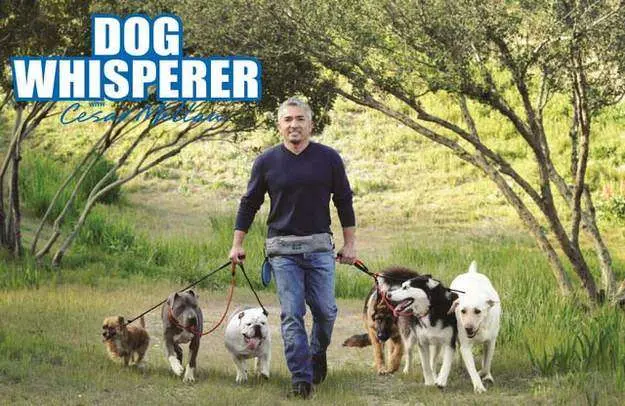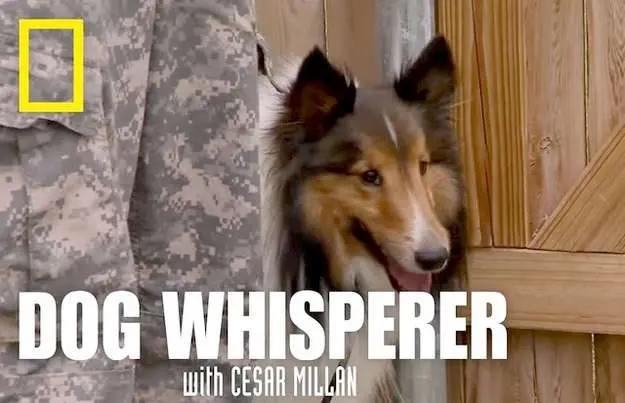What do Shelties make of The Dog Whisperer? Here's what I picked up from Cesar Millan's rehabilitation sessions with Rana the Sheltie.
The Dog Whisperer is a TV show that aims to help us understand what's going on in our dog's minds when they appear erratic, nervous, aggressive, or just plain obstinate.
Cesar Millan is controversial because at times he resorts to aggressive techniques like leash snaps, physical dominance, and shock collars.
Is there anything we can learn from him when we're dealing with small and sensitive Shelties? After all, this is a breed that's often eager to please, making them well suited to positive-only reinforcement like clicker training?
It all depends if you're dealing with a problem Sheltie. Cesar substantially deals with dogs whose behavior has gone beyond the limits of acceptability. Many of his problem dogs have come to dominate their humans, and no longer respond to their attempts at traditional dog training.
Many of these dogs are unruly, aggressive, and too confused about the family hierarchy to be trained in traditional ways.
While I've heard some pretty shocking things about Cesar Millan (especially in later seasons) there is some sense to his dominance approach when all other approaches fail. In a moment, we'll look at the episode where Cesar works with a Sheltie. But first, what's the psychology behind alpha dog theory?

The Dog Whisperer uses both positive and negative reinforcement based on alpha theory.
The Alpha Dog Theory
Cesar Millan's philosophy is based on the theory that even modern, domesticated dogs are pack animals who seek to follow a dominant leader. The leader only rises to this position by physically dominating the other animals in the pack.
Alpha Dog Theory originates from studies of wolves in the 1940s. When forced to live together, wolves naturally competed for status. The animal behaviorist, Rudolph Schenkel, dubbed the male and female who won out as the "alpha pair".
Later, other scientists criticized this premise. In the wild, wolves actually live in nuclear families, not randomly assembled units as in the study. Today, many animal behaviorists have switched away from alpha theory because of the unnatural experimental setup.
It's now thought that pack hierarchy doesn't involve a fight to the top, but a natural inclination for puppies to follow their parents' lead.
Yet Cesar maintains that dogs instinctively dominate other pack members because, just like in the original experiment, they're unnaturally taken from their litters and placed into human families.
Many animal species—including humans—naturally organize themselves into social hierarchies. It designates the most competent and confident members of society to lead others. But the system isn't immune to dysfunction.
When mental dominance (like intellect, charisma, or popularity) fails, humans resort to physical dominance (bullying, fighting, or punishment) to gain a power advantage.
It's possible that ill-adjusted dogs, just like ill-adjusted humans, also resort to aggression as a means of taking charge.
On this basis, Cesar demonstrates a firm approach to rehabilitating ill-adjusted dogs. He does so by out-aggressing them in the only language they have come to understand.
Is this kind of aversive training the only solution for problem dogs? Some opponents say no, which is why Millan is still so controversial. To compound the issue, The Dog Whisperer reminds us it's not the dog's fault when he exhibits neurotic or aggressive behavior; the owner has put the dog in an impossible position.
Cesar believes many pet owners don't act like the pack leaders that our adopted dogs seek to follow. Dysfunctional dogs may then feel compelled to assume the alpha role, even when they don't have the leadership capacity.
And this is one reason why some dogs display aggressive and unpredictable behaviors like excessive barking, anxiety, growling, and biting.
Rana The Sheltie vs The Dog Whisperer
In The Dog Whisperer, Cesar deals with a highly strung Sheltie who barks at anything—from toasters to telephones. It comes across as a wild, aggressive behavior to his frazzled owners.
Cesar theorizes that this behavior is caused by the owners treating their maladjusted Sheltie like a baby. They shower him with affection but never show him discipline to define the limits of bad behavior.

The Dog Whisperer features Rana the barking Sheltie in Season One.
Imagine a child who has plenty of nurture but no structure. In the absence of boundaries, he pushes further and further into undesirable behaviors until all hell breaks loose. If this also applies to dogs, a Sheltie without boundaries could also become an unmanageable member of the family.
Without a leader, Rana designated himself the alpha dog. But in lacking the self-discipline of a true leader, he became extremely anxious about perceived threats in the home.
Rana saw unusual sights and sounds as a need to sound the alarm, whipping his owners into a nervous frenzy. His alarm dog tendency went into overdrive.
Cesar began by putting Rana on a leash to signal that he was the alpha. His aim was to put the over-reactive Sheltie into a more submissive state of mind.
Then Cesar stood by the toaster and had it pop in front of Rana. The dog was clearly anxious and alarmed. Restrained on the leash, he was forced to confront his fear over and over.
In psychotherapy, this is known as exposure therapy. The difference with humans is that we buy-in to the treatment, knowing it's a simulated experience for our own good. The dog doesn't know that.
After some time, Rana was physiologically unable to maintain a state of constant anxiety. He began to feed off the energy of the Dog Whisperer, which was calm and authoritative. Eventually, Rana submitted to Cesar's toast-popping whims and overcame his fear.
This tough love approach is hard for many dog lovers to accept. But to be fair, it worked. That afternoon of high anxiety for Rana saved him years of ongoing stress.
As soon as the anxiety subsided, Rana then experienced a series of positive reinforcements. The Sheltie began to build positive associations with the toaster, generating a new learned behavior. Rana didn't need to bark at it anymore.
For Cesar, it was then a case of teaching Rana's owners to behave the same way, and reinforce the calm state of mind until it was fully habituated.
The Dog Whisperer Controversy
We love our dogs, and don't want to see them suffer on any level. This is why Cesar Millan has attracted some harsh critics, who say that the alpha dog theory means unnecessarily dominating dogs until they break into a submissive state of mind.
Cesar Millan claims the other dogs don't resent their leader—they respect him. Nor do they resent their subservient place in the pack. For a dog, simply knowing his place makes him feel at ease, and as long as he has a calm-assertive leader to follow, life is good.
If the events on the show are reflected truthfully, Cesar's theory is supported by numerous demonstrations of converting ill-adjusted dogs to a calm and obedient state of mind.

Cesar Millan with a Pomeranian.
Dogs that are abused, mistreated, or simply lack boundaries can develop abnormal psychological habits. They can become confused, neurotic, and aggressive, making them potentially dangerous to humans.
If such dogs can't be rehabilitated, they may eventually be put down. It's dog trainers like Cesar Millan and Victoria Stillwell and others—even when using competing psychological theories—who have the skills to turn these dogs around.
Affection vs Discipline
The Dog Whisperer is not all about commanding discipline. Cesar says this a small but important part of a dog's development, and should be counterbalanced by lots of love, play, and affection.
But many people forget to reinforce the discipline. They figure that all stops when their puppy is housetrained and can walk on a leash. Yet a dog will continually test the boundaries if they sense there's more space for them to roam.
Once we set the boundaries of appropriate behavior, we can have all the snuggles we want and still have a psychologically healthy dog. As long as it's on our terms.
So what are the terms? Here's a classic example.
Many of us play with our Shelties as soon as we get home, when they're hyped up in relief of our return. But this actually rewards a hyperactive state of mind, encouraging them to bark every time we walk through the front door.
What's more, if you think your Sheltie is already on the nervous end of the spectrum, is it wise to praise and encourage this over-excited behavior under such circumstances?
The Dog Whisperer tell us that the best time to give our dogs affection is when they're already calm, thereby reinforcing that temperament. Overall, it's better for us and our Shelties if we repeatedly reinforce these associations.
So next time you get home, try leaving your Sheltie alone for a few minutes. Allow him to calm down before praising him and giving him all the attention in the world.
Final Thoughts
I have learned more about boundaries and discipline while watching The Dog Whisperer. As dog lovers, we need all the help we can get to nurture the beautiful, if sometimes confounding, relationships we have with our furballs.
Eliminate disruptive and dangerous behaviors is in the interest of your own safety and sanity. Living with a maladjusted dog can be seriously stressful, negatively impacting on everyone in the house. We owe it to our dogs to entrain calm and obedient behaviors, and we owe it to ourselves and our families as we live with them.
How you do that is up to you. If you're looking for a gentle way to train your Sheltie in obedience, there's no need to start with Cesar's technique for troubled dogs. Instead, I recommend you take a look at clicker training for Shelties.

How to Groom Your Sheltie at Home

The Best Brushes for Shelties

10 Things to Know About Shelties

101 Sheltie Names

10 Intelligent Dog Breeds

Stop Destructive Chewing

Should You Shave a Sheltie?

20 Things You Need for a New Puppy

